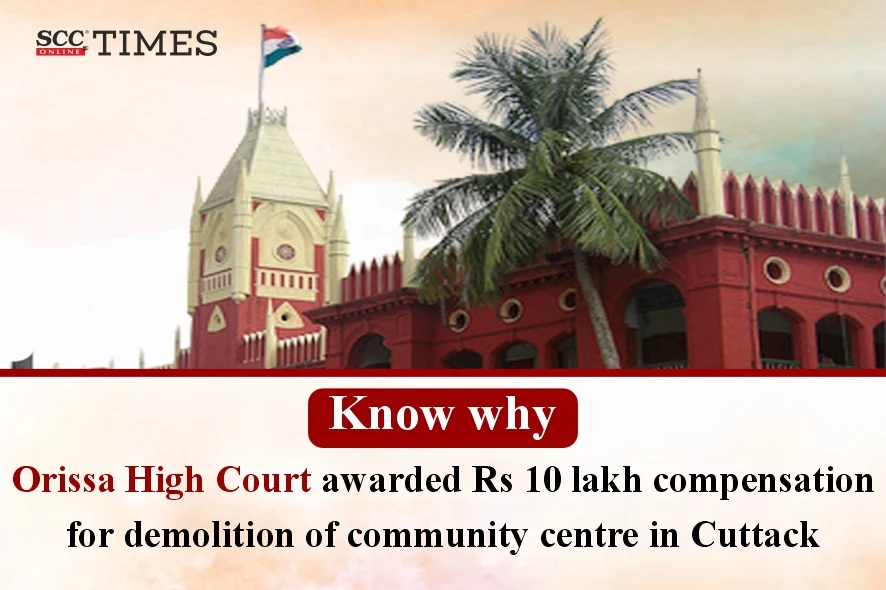Orissa High Court: A writ petition was filed wherein the petitioner sought a direction to declare the demolition of the community structure as illegal, order its reconstruction at State expense, award compensation for loss and hardship suffered, and initiate proceedings against officials responsible for violating binding judicial orders and constitutional safeguards. A Single Judge Bench of Dr. S.K. Panigrahi, J., allowed the petition and observed that forcible dispossession of a person from their property, without adherence to due process of law, constituted not only a violation of their constitutional right under Article 300-A of the Constitution but also an affront to basic human rights. The Court held that the Tahasildar showed undue haste in demolishing the structure, without adhering to the guidelines issued and thus, ordered compensation of Rs 10 lakh.
Background:
The dispute concerned a structure known as the ‘Gosthigruha’ or community centre, built on land classified as Gochar (grazing) land and governed by the Odisha Prevention of Land Encroachment Act, 1972 (‘OPLE Act’). The petitioner argued that the structure had existed in some form since 1985, was repaired after the 1999 cyclone, and later reconstructed between 2016 and 2018 using public funds. The community centre was used by villagers for public utility purposes, including awareness drives, yoga camps, health check-ups, and government outreach programmes. Despite its classification as Gochar land, the construction was neither objected to by authorities nor forcibly encroached, and the villagers expressed readiness to exchange homestead land for the portion used.
The petitioners challenged the encroachment proceedings initiated under the OPLE Act in July 2024, which were disposed of by the Court with a direction to file an application for settlement. However, the application was rejected on grounds including lack of documentary proof of continuous possession, inauthenticity of resolutions, non-compoundability of the land category, and absence of registration. Following this, the petitioners filed an appeal before the Sub-Collector, and the Court simultaneously directed that no eviction should take place during the pendency of the appeal. Despite this order, a fresh eviction notice was issued, prompting the petitioners to approach the Court again, which on 13-12-2024 reiterated the earlier stance and restrained eviction during the pendency of the appeal.
On the same day, the Sub-Collector concluded the hearing and reserved orders in the appeal. However, a demolition notice was affixed which indicated that the structure would be demolished the next morning. The structure was demolished on 14-12-2024 without affording the petitioners adequate time to challenge the order or vacate the premises.
The petitioner contended that the demolition of the structure was in violation of the procedural safeguards like show cause notice, hearing, recording of reasons, waiting period, and transparency and the demolition with just 17 hours’ notice of intimation, without a prior show cause notice, was unlawful. It was further argued that the State actors, including Tahasildar and Sub-Collector, were under a constitutional obligation to act fairly, transparently, and within the bounds of law.
The opposite parties alleged that the structure in question was an unauthorised encroachment on Gochar land and despite being given opportunities under the OPLE Act, the petitioners failed to establish any legal right or valid possession and, thus, the demolition was a lawful enforcement action carried out in accordance with statutory powers.
Analysis and Decision:
The Court observed that the petitioners had occupied the land in question for over three decades and the structure had received government-sanctioned funds for reconstruction and was being used for welfare purposes. The Court emphasised that the sequence of events raised not just concerns of administrative lapse, but of deeper institutional failure, since an act as final and irreversible as demolition was carried out despite two standing judicial directions.
The Court relied on Directions in the Matter of Demolition of Structures, In re, (2025) 5 SCC 1 (‘Directions in the Matter of Demolition of Structures Case’), wherein mandatory directions were issued by invoking Article 142 of the Constitution, stipulating that no demolition should occur without a 15-day show cause notice, a reasoned order explaining why demolition was the only viable option, a fair opportunity for appellate and judicial scrutiny, video documentation of the demolition process, and uploading of all notices and orders on a digital portal to ensure transparency. The Court observed that none of these conditions were fulfilled in the present case.
The Court held that forcible dispossession of a person from their property, without adherence to due process of law, constituted not only a violation of their constitutional right under Article 300-A but also an affront to basic human rights. Further, the protection under Article 300-A was not merely procedural but substantive in nature since it drew a constitutional boundary around the exercise of state power over property. The Court further relied on Delhi Airtech Services (P) Ltd. v. State of U.P., (2011) 9 SCC 354, wherein it was affirmed that when executive action defied the twin pillars of rule of law and separation of powers, the doctrine of public trust was not merely implicated, it was triggered as a shield for the public interest.
The Court emphasised that the law was not self-executing as it depended on officers who were expected to act with fairness, honesty and within the limits of their legal authority and when decisions were taken in haste, or authority was used without proper justification, the consequences were not merely administrative as it affected not just the immediate parties but the public’s confidence in institutions. The Court further highlighted the growing and troubling pattern commonly referred to as “bulldozer justice”, where executive power backed by machinery rather than reason, supplanted legal process and the use of demolition as a tool of enforcement, absent procedural compliance and judicial finality, transformed what should be a lawful act into a coercive one.
The Court allowed the petition and held that the Tahasildar had shown undue haste in demolishing the structure, without adhering to the guidelines issued. Thus, the Court ordered compensation of Rs 10 lakh, out of which Rs 2 lakh was to be recovered from the Tahasildar and Rs 8 lakh had to be paid by the State to the petitioners.
The Court directed that departmental proceedings should be initiated against the Tahasildar. The Court further directed the Chief Secretary to immediately issue detailed guidelines to all the Revenue officials and Municipal authorities of the State considering the guidelines issued by the Supreme Court in Directions in the Matter of Demolition of Structures Case (supra).
[Kumarpur Sasan Juba Gosti Kendra v. State of Orissa, 2025 SCC OnLine Ori 2593, decided on 20-6-2025]
Advocates who appeared in this case :
For the Petitioners: Ninad Laud, Advocate along with L.K. Moharana, Advocate
For the Opposite Parties: J. Sahoo, ASC




